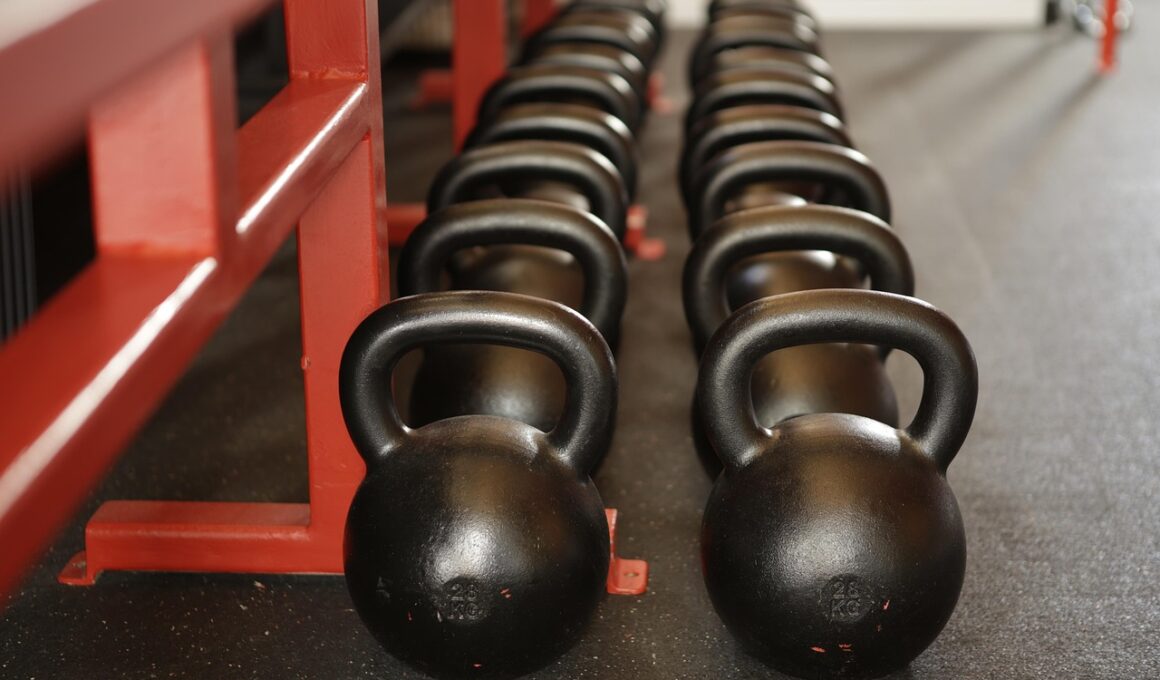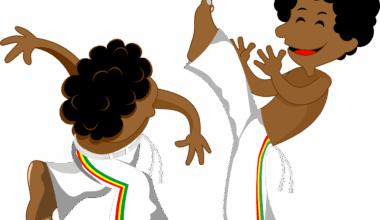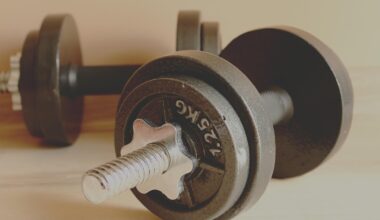Tips for Improving Posture While Lifting Weights Safely
When lifting weights, maintaining proper posture is crucial for overall safety and effectiveness. Many individuals often overlook this aspect, leading to potential injuries. Begin by positioning your feet shoulder-width apart; this stable base is critical. Your toes should point slightly outward, creating a natural alignment with your knees. Next, focus on your back alignment. Keep it straight while lifting, ensuring that it doesn’t round excessively. Engaging your core muscles is vital; they support your spine, maintaining a neutral position throughout your lift. Don’t forget about your head and neck; keep your gaze forward and relaxed. Always breathe properly too; inhaling before the lift and exhaling during can enhance stability. Equally important is warming up; a few dynamic stretches can prepare your muscles for heavier loads. Consider consulting with a personal trainer to establish a routine specific to your needs. Emphasizing this foundation helps you progress safely. Finally, stay mindful of your limits. Gradually increase your weights rather than jumping into heavier loads. This care will allow you to lift effectively while minimizing injury risks.
Common Posture Mistakes to Avoid
While improving posture during lifting, it’s important to recognize and avoid common mistakes. Rounding or overarching the back is a frequent issue, which has serious repercussions. When the back rounds, it misaligns the vertebrae, increasing the risk of herniated discs and other injuries. Ensure you’re aware of spinal alignment and maintain a straight posture as much as possible. Another mistake is allowing the knees to buckle inward as you lift. This misalignment can lead to severe strain and even long-term joint damage. Instead, focus on pushing your knees outward slightly to track with your toes, which ensures correct form. Moreover, don’t overlook the importance of shoulder positioning; allowing them to creep up toward the ears is a common fault. Keep your shoulders relaxed and down to prevent neck strain and stress. Moreover, using equipment improperly can lead to poor posture habits. Ensure you’re utilizing your weights, resistance bands, and other equipment correctly. Lastly, avoid lifting weights that are too heavy for your current strength level; it’s better to build gradually than risk injury.
Another important aspect of maintaining proper posture is wearing appropriate footwear. Shoes designed for weightlifting provide necessary support and stability during exercises. Ensure the shoes are flat-soled, minimizing any elevation that could compromise your balance. This allows you to feel grounded, enhancing your lift performance and reducing injuries. Additionally, selecting the right surface for lifting can greatly impact your posture. Lifting on a flat, stable surface minimizes the chance of slipping or losing balance, further supporting a correct lifting position. Proper hydration cannot be overlooked either; dehydration can lead to decreased coordination and muscle fatigue. Ensure you stay well-hydrated before and during workouts for optimal performance. When lifting among peers or in a gym setting, occasionally ask for feedback. A spotter or fellow gym member can observe your technique and suggest improvements. Don’t hesitate to ask for tips or watch experienced lifters to absorb best practices. Utilize mirrors in gyms; they can help you monitor your posture during lifts, providing immediate feedback visually. Lastly, remember that consistency is key; practicing good posture during every lift will reinforce proper habits that become second nature over time.
Incorporating Stretching for Better Posture
Incorporating stretching routines into your program can significantly enhance your posture while lifting weights. Stretching increases flexibility, which allows for a broader range of motion during workouts. Improved flexibility makes it easier to maintain proper positions throughout various lifts. Focus on the muscles used most in lifting, such as the hamstrings, quads, and hip flexors. Targeting these areas will alleviate tightness that may restrict your capacity to lift safely. Consider including dynamic stretches before workouts to stimulate your muscles and prepare them for heavy activity. After completing your session, opt for static stretching to cool down and lengthen the muscles that worked hard. A good sequence might start with lunges, moving to quadriceps stretches, and finishing with upper body stretches for the shoulders and back. Post-workout stretching aids in recovery, reducing soreness, and promoting better flexibility. Furthermore, regularly practicing yoga or Pilates can contribute to improved core strength and postural awareness. This additional training can carry over to weightlifting, enhancing your overall approach. Make stretching an integral part of your routine, and observe significant improvements in your weightlifting posture.
Another highly effective method to maintain proper posture while lifting is utilizing imagery and concentration techniques. Visualize yourself completing the lift with perfect posture, focusing on each body part’s alignment during the action. This mental rehearsal can lead to improved performance, as your mind supports your body. Additionally, practice mindful lifting; concentrate on how each muscle engages throughout the movement. Being aware of your body positioning adds an extra layer of mindfulness, subsequently improving your posture. Using reminders during workouts can also reinforce proper stance. Place sticky notes on your equipment or within your field of vision to prompt you consistently to check your positioning. It can be a simple phrase such as ‘Lift with your back straight.’ These reminders help reconstruct your mindset over time, helping solidify good posture habits. Remember, building these habits takes time. Incorporate posture cues into your warm-up and engage during functional movements. Keep track of your progress; take short videos of your lifts for personal review later. Observing your form over weeks will highlight improvements and areas still needing focus.
The Role of Recovery in Posture Improvement
Prioritizing recovery is essential in your journey toward improved lifting posture. After intense workouts, allowing your body to heal can substantially promote your muscle alignment and readiness for future lifts. Overworking your muscles can lead to stiffness and misalignment, which negatively impacts your lifting posture. Incorporate rest days into your schedule, allowing muscle fibers time to recover and regenerate properly. Using techniques such as foam rolling can alleviate tension and promote better blood flow, aiding recovery significantly. Incorporating relaxation exercises, such as deep breathing or meditating, can also support recovery; these practices can decrease muscle tension. Furthermore, stay attentive to signs of fatigue or soreness during workouts; never push through pain that steadily worsens. Turning a blind eye to these signals may lead to poor lifting mechanics and hinder posture improvement. Additionally, maintaining a balanced diet ensures your body has the nutrients necessary for effective recovery. Protein intake, in particular, supports muscle repair and growth. Overall, fostering a comprehensive recovery approach will enhance your posture while lifting, predicting your performance in future sessions.
In conclusion, enhancing your posture while lifting weights is a multifaceted endeavor. It requires attention to alignment, awareness of common mistakes, proper footwear, and an effective stretching routine. Incorporating mental techniques and prioritizing recovery further enhances your performance. Always conduct self-assessments through video recordings or feedback from trainers or peers, actively reflecting on your form and technique. With dedicated effort toward implementing these tips, you are likely to see significant changes in your lifting posture. Gradually, improved form will translate into additional weight capacity, better overall strength, and reduced risk of injury. Adapting habits takes time; focus on each aspect rather than aiming for immediate perfection. Consider documenting your progress to observe how your posture and performance evolve. A tracking system can offer motivation and assertion of goal completion. Lastly, remember to celebrate your milestones, regardless of their size. Acknowledge the commitment made toward proper posture and enhance your fitness journey.
Finally, imparting knowledge about your discoveries and techniques can create a supportive community around you. Sharing your experiences or minor successes encourages not only further learning but also bonds individuals pursuing similar fitness goals. Engage in conversations about proper lifting techniques, remedies to common mistakes, or stretching routines you find effective. Online forums, social media groups, and participation in local fitness communities create platforms for such discussions. This communal sharing fosters accountability and motivation as members uplift one another in their fitness journeys. Moreover, consider creating a blog to document your learning experiences. Writing about your posture improvement journey can reinforce your understanding while providing valuable insights to others navigating similar paths. Ultimately, maintaining a focus on posture is akin to cultivating a practice; it develops over time with diligent effort and keen awareness. It’s not merely about lifting weights, but also embracing ethical and safe practices for your muscles and joints. In essence, committing to improvement, recovery, education, and sharing establishes the groundwork for a very fulfilling lifting experience.


